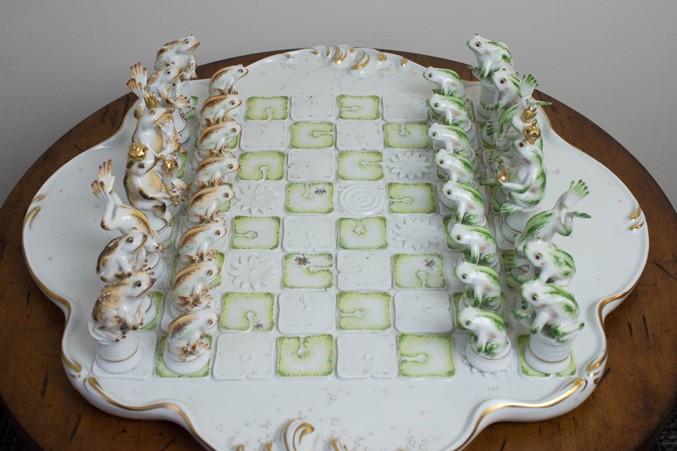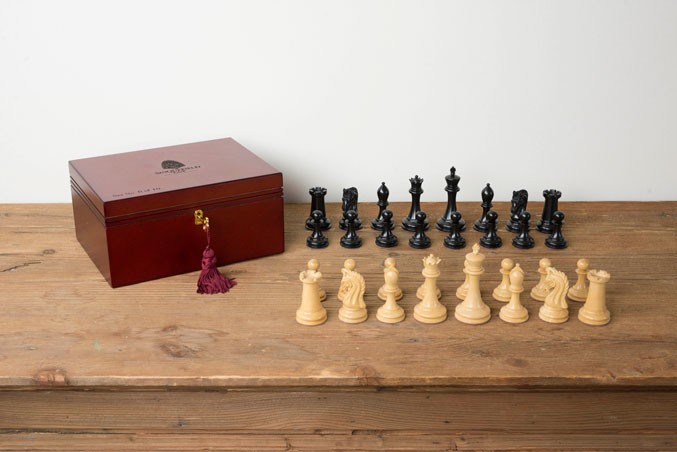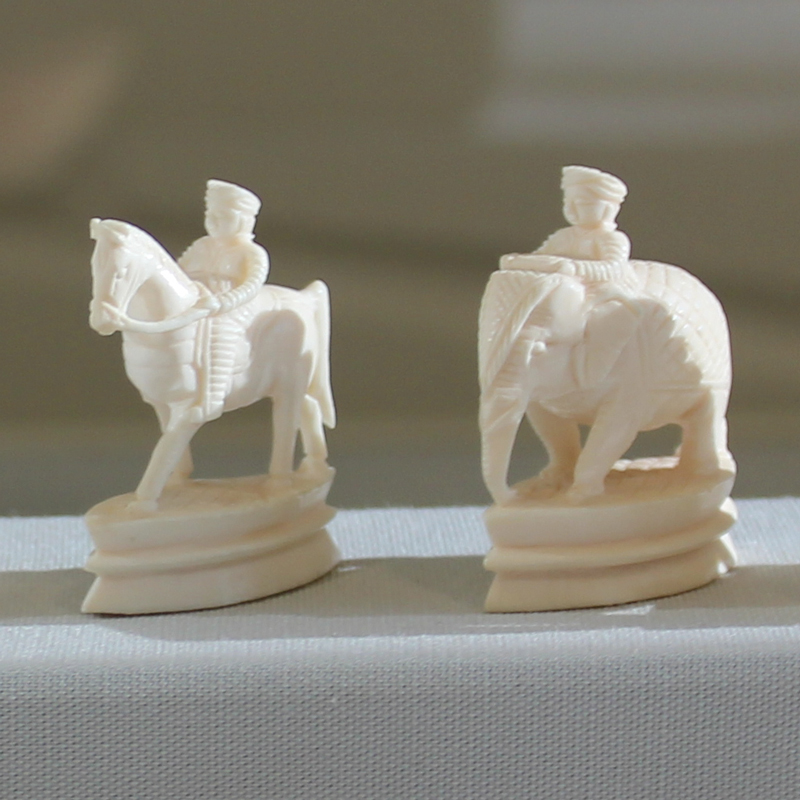Through the Featured Chess Set project, the World Chess Hall of Fame showcases a variety of chess sets throughout the year. These include highlights from the institution’s collection as well as chess sets owned by Saint Louis metropolitan area friends and chess lovers who have special stories to accompany their sets.
Do you live in the Saint Louis metropolitan area and have a chess set with a great story? Submit it for inclusion in our Featured Chess Set project! This program highlights chess sets with interesting backgrounds borrowed from chess lovers and fans of the Hall of Fame. Featured chess sets are displayed for a period of one month at the World Chess Hall of Fame.
If you would like to participate in the program, send a photo and the story of the set to Emily Allred, Assistant Curator, at [email protected].
January

Justin Bailey
Cellulose Chess Set
2014
King size: 6 1/8 in.
ABS Plastic
Collection of Justin Bailey
Photo © David Wolk
Justin Bailey, a former employee of the World Chess Hall of Fame, created January’s Featured Chess Set. Of making this set he said, “Seeing exhibitions like Prized & Played: Highlights from the Collection of Jon Crumiller, I was very inspired by both the design and craft traditions that went into creating a chess set. Currently as a graduate student at the University of Iowa studying 3D Design as well as prototyping for 3D printing, I wanted to design a set that could relate new methods in design and craft.”
Cellulose, the structural fiber network that makes up the walls of plants provided the inspiration for this chess set. Elements of natural architecture are supplemented by the familiar iconography of Staunton-style chess pieces. The tops of the pieces form castellation atop the rooks, horses’ heads in the knights, mitres on the bishops, a crown for the queens, and crosses on the kings. The intertwined stalks also evoke the complexity of chess, alluding to the number of potential moves that could be made by each piece on the board.
February

Programmer: Takashi Kurosaki
Artists: Bryan Ellis, Mike Fisher, Martin Smith, and Alex Velez
Chess with Zombies: Pawn of the Dead
2015
Digital format
Courtesy of Takashi Kurosaki
The World Chess Hall of Fame is presenting February’s featured chess set courtesy of Takashi Kurosaki. Kurosaki began playing at San Francisco’s Mechanics’ Institute at age fourteen and three years later earned the title of national master. In 1972, he played in the U.S. Junior Closed Tournament, which was sponsored by Jacqueline Piatigorsky. The following year, he won the California Junior Chess Championship, in a field which included future U.S. Chess Hall of Fame inductee Diane Savereide. After a break of about twenty years, Kurosaki began playing chess again in the 1990s. His background as a programmer led him to create Chess with Zombies, a playful contemporary take on the ancient game of chess.
Inspired by the prevalence of zombies in popular culture, Takashi Kurosaki and his artist collaborators created this chess program, in which an undead army battles human forces. Mike Fisher, an artist known for creating artwork for album covers, posters, and t-shirts for metal and mainstream bands, designed the quirky zombie pieces. Kurosaki’s own background as a tournament chess player led him to emphasize that the pieces be easily recognizable despite their untraditional appearances.
March

Kati Zorn
Manufacturer: Elder Volkstedt Porcelain Factory
Frog Chess Set
c. 1982-1999
Porcelain
Collection of the World Chess Hall of Fame
Photo © Austin Fuller
March’s Featured Chess Set is part of the collection of the World Chess Hall of Fame (WCHOF). Since its creation in 1986, the WCHOF has endeavored to highlight the history and cultural significance of the game of chess. The WCHOF collection is diverse, including sets once owned by legendary players, mass-produced sets with lively pop culture themes, antique ivory sets, travel sets, as well as early computer chess sets. Through these artifacts, the WCHOF illustrates how chess has evolved through the course of its over 1500 year history.
In this whimsical ornamental chess set, two courts of frogs compete on a board with squares made of lily pads and flowers. The set includes humorous elements, including a diving frog whose legs echo the shape of a bishop’s mitre or hat and a frog king, perhaps a reference to the fairy tale of the frog prince. Artist Kati Zorn created the set while employed by the Elder Volkstedt Porcelain Factory. Founded in 1760, the manufacturer is located in Thuringia, a region of Germany known for its production of porcelain.
April

The Franklin Mint
Coca-Cola® Chess Set
1996
Cast Pewter with 24 karat gold plate and red and white enamel trim
King size: 2 1/4 in.
Collection of the World Chess Hall of Fame
Photo © Michael DeFilippo
April’s Featured Set has been chosen to complement the upcoming opening of Kingside Diner, the newest addition to the Saint Louis Chess Campus. Located across the street from the World Chess Hall of Fame, the restaurant will offer breakfast, lunch, and dinner for chess lovers.
These beautiful chess pieces are part of the first Coca-Cola® chess set created by The Franklin Mint. The set was originally accompanied by a red and white chess board inspired by Coca-Cola stained glass lamps dating from the early 1900s. The nostalgic chess pieces are based on the design of a 1890s Coca-Cola syrup dispenser and accented with 24 karat gold. Sold in over 200 countries, Coca-Cola® or “Coke” was first introduced in 1886 and is the best-selling soft drink in history. The beverage was originally sold as a patent medicine.
May

John Collins Chess Set and Box
Date Unknown
Wood
King size: 3 in.
Box: 8 x 5 1/2 x 2 5/8 in.
Collection of the World Chess Hall of Fame, gift of John Collins
May’s Featured Chess Set is part of the collection of the World Chess Hall of Fame. John “Jack” Collins, a 1991 inductee to the U.S. Chess Hall of Fame, once owned the set. Collins learned to play chess as a teenager and quickly developed a passion for the game. He organized an informal group called the Hawthorne Chess Club and served as a mentor to many of the top American players of the mid-twentieth century. Collins wrote about his experiences with future top American players in My Seven Chess Prodigies, published in 1975. Another chess set once owned by Collins is on view in the World Chess Hall of Fame’s current exhibition A Memorable Life: A Glimpse into the Complex Mind of Bobby Fischer.
According to an inscription on the lid of this box, John Collins received this chess set as a gift from his sister Ethel. Ethel served as a caretaker for John, and the apartment that the two shared housed the Hawthorne Chess Club. The informal group attracted an eclectic group of chess lovers, including promising young talents and future U.S. Chess Hall of Fame inductees like Bobby Fischer and Robert and Donald Byrne as well as artists like John Cage and Marcel Duchamp.
June

Russian Mammoth
Richard the Lion-Hearted and Saladin
c. 2004
Mammoth ivory with wooden bases
King size: 3 5/8 in.
Collection of the World Chess Hall of Fame, gift of Nikolai Timoshuk
Nikolai Timoshuk donated June’s featured chess set to the World Chess Hall of Fame. Timoshuk is the president of Russian Mammoth, a company that produces sets that embody a variety of historical and cultural themes, and a member of Chess Collectors International.
While created in contemporary times, this chess set is made of a prehistoric material—mammoth ivory. The set embodies a historical theme, the Third Crusade, which took place from 1189-1192 CE. Here, King Richard I of England leads an army of knights against Saladin, the sultan of Egypt and Syria who had retaken Jerusalem from the crusaders. The European side includes unicorns, symbols associated with the knighthood. Though in this set, the European forces are depicted as White, Russian Mammoth has created sets with the colors reversed for Muslim patrons.
July

CBK, Ltd.
Safari Chess Set
2000
Resin
King: 5 7/8 in.
Board: 17 x 17 in.
Collection of the World Chess Hall of Fame, gift of Linwood Mason
Linwood Mason donated July’s Featured Chess Set to the World Chess Hall of Fame (WCHOF). Mason received the set as a gift from his family, who knew of his love of chess. Mason, in turn, gave the set to the WCHOF in 2015, wishing to share the set with visitors to the institution.
Lions and lionesses rule as kings and queens on this jungle-themed board. Their animal armies include giraffes as bishops, zebras as knights, elephants as rooks, and tigers as pawns. The board accompanying this decorative set is adorned by leafy vegetation on its corners and supported by big cats’ paws.
August

The House of Staunton
2013 Sinquefield Cup Chess Set
2013
Boxwood, ebony, and mahogany
King size: 3 7/8 in.
Box size: 4 ¾ x 9 ¾ x 7 ¼ in.
Collection of the World Chess Hall of Fame
Frank Camaratta designed August’s featured chess set during the preparations for the first Sinquefield Cup tournament, which took place in 2013. A tournament chess player and chess set collector, Camaratta began designing sets in the early 1990s. Through The House of Staunton, which he founded in 1998, Camaratta sought to fill a need for high-quality sets as well as reproductions of historical pre-Staunton styles of chess sets. Though he sold the company in 2007, Camaratta continues to design and consult for The House of Staunton.
Commissioned by the Chess Club and Scholastic Center of Saint Louis, this set was created in a special limited edition of 10 in honor of the first Sinquefield Cup tournament. For the competition, Camaratta designed the first weighted DGT chess pieces, which allowed games to be broadcast for tournament followers while also providing better quality sets for the players. The set is based upon Camaratta’s Imperial Collector set design, which features unique knights inspired by unicorns.
September

Battle for Tenochtitlán
1985
Tin, wood
King size: 4 in.
Board size: 23 x 23 in.
Collection of Clayton McDonnell
September’s Featured Chess Set is loaned to the World Chess Hall of Fame by Clayton McDonnell. McDonnell’s parents purchased the colorful set while on a trip to Mexico. The set’s historic theme appealed to his mother Cynthia, who holds a Master of Arts degree in Anthropology with a specialization in Central American archaeology.
Inspired by the Spanish conquest of the Aztec empire, this set shows Aztec forces led by emperor Moctezuma II battling against invading Spanish forces led by conquistador Hernán Cortés. Each of the sides includes historic figures and costumes. Doña Marina, a Nahua woman who was also an interpreter for Cortés, appears as the queen for the Spanish side. Jaguar warriors are the pawns for the Aztec forces.
October

Robert Rudolph Hollendonner
Hollendonner Chessmen
1978
Maple, walnut
King size: 3 1/16 in.
Board: 18 x 18 in.
Collection of the World Chess Hall of Fame, gift of Raquel Browne
October’s Featured Chess Set is a new donation to the collection of the World Chess Hall of Fame from Raquel Browne, the wife of 2003 U.S. Chess Hall of Fame inductee Walter Browne. Browne was a dominant force in American chess and won six U.S. Chess Championships. He excelled in open tournaments, earning shared or outright first place in the American Open seven times, the National Open eleven times, the U.S. Open three times, and the World Open three times. This chess set is part of a generous gift of photographs, periodicals, and other archival materials from the archive of Walter Browne.
Architect Robert Rudolph Hollendonner created this modern set with the intention of challenging the dominance of traditional Staunton chess sets in tournament settings. Each handmade piece was created using a system of spheres and squares, which were arranged in ways that allude to the pieces’ movements and meanings. To Hollendonner, the circle represented the divine while the solidity of the square symbolized wisdom, construction, and dwellings.
November

Sababa Toys
Sesame Street Deluxe Collector’s Chess Set
2004
Tin board box, plastic pieces
King size: 3 3/6 in.
Board size: 3 1/4 x 11 15/16 x 11 15/16 in.
Collection of the World Chess Hall of Fame
November’s Featured Chess Set is part of the collection of the World Chess Hall of Fame (WCHOF). Since its creation in 1986, the WCHOF has endeavored to highlight the history and cultural significance of the game of chess. The WCHOF collection is diverse, including sets once owned by legendary players, mass-produced sets with lively pop culture themes, antique ivory sets, travel sets, as well as early computer chess sets. Through these artifacts, the WCHOF illustrates how chess has evolved through the course of its over 1500-year history.
Created in commemoration of Sesame Street’s 35th season, this chess set features familiar characters from the children’s television show. Sesame Street premiered on November 10, 1969, and aspired to blend education and entertainment. Many of the show’s most beloved characters are included in this set, each wearing humorous versions of costumes from a medieval court. The pawns are lampposts with signs pointing the way to Sesame Street.
December

Star Wars Chess Set
© Lucasfilm Ltd.
Cardboard board, PVC pieces
King size: Obi-Wan Kenobi 3 ¼˝ in., Darth Vader 3 ¾ in.
Board size: 18 ½ x 18 ½ in.
Collection of the World Chess Hall of Fame
December’s Featured Chess Set is part of the collection of the World Chess Hall of Fame (WCHOF). Since its creation in 1986, the WCHOF has endeavored to highlight the history and cultural significance of the game of chess. The WCHOF collection is diverse, including sets once owned by legendary players, mass-produced sets with lively pop culture themes, antique ivory sets, travel sets, as well as early computer chess sets. Through these artifacts, the WCHOF illustrates how chess has evolved through the course of its over 1500-year history.
Inspired by the original Star Wars trilogy, this chess set includes some of the most memorable characters of the beloved series. The first film in the franchise, Star Wars: A New Hope was released by 20th Century Fox on May 25, 1977. After three successful films, the story took a sixteen-year hiatus before three prequel movies were released. A new installment, Star Wars: The Force Awakens will debut in December 2015. The franchise has grossed over $4 billion at the box office, making it one of the highest-grossing film series of all time.



